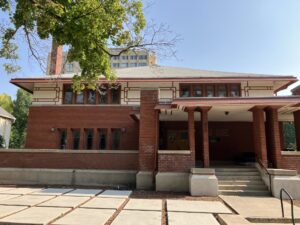Corrine Adams and Forcing Industry to Clean Up Its Act
by Bob Wyss, author of Black Gold: The Rise, Reign, and Fall of American Coal

I was virtually finished with my book, Black Gold, The Rise, Reign and Fall of American Coal, and I was desperate. One chapter was causing me fits. The book was less a history than a set of chronological narratives about key characters or events told over time. This chapter I was about the failure of American communities to fight air pollution caused by burning coal. I had visited Pittsburgh, Cincinnati, St. Louis and Chicago and while I had tidbits, I could not find a solid, detailed story or character. I had rewritten and rewritten the chapter, but it was not what I wanted.
Community leaders had mounted campaigns to fight the pollution, and some were successful, but only for a few years. Coal operators and their allies were simply too powerful for the anti-pollution campaigners, who had two problems. One was that the science that would later show how unhealthy and dangerous air pollution could be had not yet been developed. The other was that women often led these campaigns. Often these women came from the wealthiest families in a city, they were leaders of society and the arts. But they had little political power in comparison to the civic and industrial forces they faced. Not only did they lose, but it appeared that history regarded their campaigns with such little regard that details of their efforts had faded from sight.
I decided to mount one last research drive to find a crusader. Much of my research had been in archives but digital resources increasingly are expanding. I stumbled onto an online presentation of an air pollution campaign compiled by the research library at the University of Utah focused on Salt Lake City.
In 1913 and 1914 the Ladies Literary Society of Salt Lake City had campaigned to reduce the city’s air pollution. Corrine Adams, well known in the community as an artist and the wife of a prominent banker, told a hundred members at the society’s inaugural meeting of the new season in the fall of 1913 that she did not want to focus on the arts or literature. Instead, she wanted new laws passed at city hall to force industry to clean up its air emissions.
I found a trove of articles by the city’s three major newspapers at the time on both the air pollution problems and on this new drive to resolve them. A story in the Salt Lake Tribune of Nov. 19, 1912 was headlined: Dense Smoke is Bane of Modern City, Fosters Tuberculosis Germs and Undermines Health of People.” The more I read, the more I began to realize I might be close to finding my chapter.
I needed more about Corrine Adams. There were several small biographies and stories she had written, primarily about her artwork. She had died in 1951, her husband in 1936. I wondered if she still had any children or grandchildren who were still alive.

And then I found something that dramatically changed the story. I have taught journalism for many years, and I sometimes tell students about what I call the “magic moment” in reporting. It happens unexpectedly, in going through reams of dusty records, or in an unpromising interview, or visiting a scene with very little promise. In this case it involved Corrine Adams only son, Damon. He died unexpectedly at 16-years-old in 1910. A digital record popped up on the scene. It was a death certificate. The cause of death was in the lower right corner – Tuberculosis.
That was the moment, the key. I knew, or could at least strongly suspect, what had motivated Corrine Adams to abandon her longtime study of Robert Browning to launch a political campaign to clean up the city’s air. Pollution had not killed Damon Adams, but it had likely contributed to his death. It was the “magic moment” when I knew I had a compelling story, a new chapter.
Corrine Adams did win her campaign; city officials reluctantly passed a new law requiring industry to reduce pollution emissions. For a few years the law was enforced until the city reported it ran out of money and the pollution returned.
Before I wrote the new chapter, I did visit Salt Lake City. I toured the literary club’s once expensive building that is now in private hands, I saw the houses where she lived, and I viewed the records of the club. I could not find any records of Corrine Adams talking about her son. She had kept it her own personal story, probably deciding not to exploit it. It did not matter. I knew what had happened to her son, and so would the readers.
